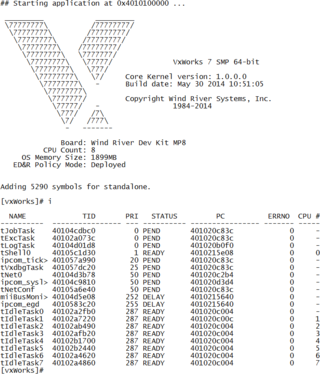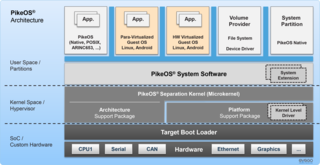Related Research Articles

QNX is a commercial Unix-like real-time operating system, aimed primarily at the embedded systems market.
L4 is a family of second-generation microkernels, used to implement a variety of types of operating systems (OS), though mostly for Unix-like, Portable Operating System Interface (POSIX) compliant types.
In computer architecture, 64-bit integers, memory addresses, or other data units are those that are 64 bits wide. Also, 64-bit central processing units (CPU) and arithmetic logic units (ALU) are those that are based on processor registers, address buses, or data buses of that size. A computer that uses such a processor is a 64-bit computer.

VxWorks is a real-time operating system developed as proprietary software by Wind River Systems, a subsidiary of Aptiv. First released in 1987, VxWorks is designed for use in embedded systems requiring real-time, deterministic performance and, in many cases, safety and security certification for industries such as aerospace, defense, medical devices, industrial equipment, robotics, energy, transportation, network infrastructure, automotive, and consumer electronics.
In computing, security-evaluated operating systems have achieved certification from an external security-auditing organization, the most popular evaluations are Common Criteria (CC) and FIPS 140-2.

Unified Extensible Firmware Interface is a specification that defines the architecture of the platform firmware used for booting the computer hardware and its interface for interaction with the operating system. Examples of firmware that implement the specification are AMI Aptio, Phoenix SecureCore, TianoCore EDK II, InsydeH2O. UEFI replaces the BIOS which was present in the boot ROM of all personal computers that are IBM PC compatible, although it can provide backwards compatibility with the BIOS using CSM booting. Intel developed the original Extensible Firmware Interface (EFI) specification. Some of the EFI's practices and data formats mirror those of Microsoft Windows. In 2005, UEFI deprecated EFI 1.10.
The LynxOS RTOS is a Unix-like real-time operating system from Lynx Software Technologies. Sometimes known as the Lynx Operating System, LynxOS features full POSIX conformance and, more recently, Linux compatibility. LynxOS is mostly used in real-time embedded systems, in applications for avionics, aerospace, the military, industrial process control and telecommunications. As such, it is compatible with military-grade security protocol such as wolfSSL, a popular Transport Layer Security (TLS/SSL) library.

Green Hills Software is a privately owned company that builds operating systems and programming tools for embedded systems. The firm was founded in 1982 by Dan O'Dowd and Carl Rosenberg. Its headquarters are in Santa Barbara, California.
A hypervisor, also known as a virtual machine monitor (VMM) or virtualizer, is a type of computer software, firmware or hardware that creates and runs virtual machines. A computer on which a hypervisor runs one or more virtual machines is called a host machine, and each virtual machine is called a guest machine. The hypervisor presents the guest operating systems with a virtual operating platform and manages the execution of the guest operating systems. Unlike an emulator, the guest executes most instructions on the native hardware. Multiple instances of a variety of operating systems may share the virtualized hardware resources: for example, Linux, Windows, and macOS instances can all run on a single physical x86 machine. This contrasts with operating-system–level virtualization, where all instances must share a single kernel, though the guest operating systems can differ in user space, such as different Linux distributions with the same kernel.

QEMU is a free and open-source emulator. It emulates a computer's processor through dynamic binary translation and provides a set of different hardware and device models for the machine, enabling it to run a variety of guest operating systems. It can interoperate with Kernel-based Virtual Machine (KVM) to run virtual machines at near-native speed. QEMU can also do emulation for user-level processes, allowing applications compiled for one architecture to run on another.

In computer science, hierarchical protection domains, often called protection rings, are mechanisms to protect data and functionality from faults and malicious behavior.
In C and related programming languages, long double refers to a floating-point data type that is often more precise than double precision though the language standard only requires it to be at least as precise as double. As with C's other floating-point types, it may not necessarily map to an IEEE format.

PikeOS is a commercial hard real-time operating system (RTOS) which features a separation kernel-based hypervisor. This hypervisor supports multiple logical partition types for various operating systems (OS) and applications, each referred to as a GuestOS. PikeOS is designed to facilitate the development of certifiable smart devices for the Internet of Things (IoT) by adhering to high standards of quality, safety, and security across different industries. In instances where memory management units (MMU) are not present but memory protection units (MPU) are available on controller-based systems, PikeOS for MPU is designed for critical real-time applications and provides up-to-standard safety and security.
The following is a timeline of virtualization development. In computing, virtualization is the use of a computer to simulate another computer. Through virtualization, a host simulates a guest by exposing virtual hardware devices, which may be done through software or by allowing access to a physical device connected to the machine.
A separation kernel is a type of security kernel used to simulate a distributed environment. The concept was introduced by John Rushby in a 1981 paper. Rushby proposed the separation kernel as a solution to the difficulties and problems that had arisen in the development and verification of large, complex security kernels that were intended to "provide multilevel secure operation on general-purpose multi-user systems." According to Rushby, "the task of a separation kernel is to create an environment which is indistinguishable from that provided by a physically distributed system: it must appear as if each regime is a separate, isolated machine and that information can only flow from one machine to another along known external communication lines. One of the properties we must prove of a separation kernel, therefore, is that there are no channels for information flow between regimes other than those explicitly provided."

ELinOS is a commercial development environment for embedded Linux. It consists of a Linux distribution for the target embedded system and development tools for a development host computer. The development host computer usually is a standard desktop computer running Linux or Windows. The Linux system and the application software for the target device are both created on the development host.
Windows NT is a proprietary graphical operating system produced by Microsoft as part of its Windows product line, the first version of which was released on July 27, 1993, and it lives on today since the latest version of Windows, 11, includes its technology.

T-Kernel is an open source real-time operating system (RTOS) designed for 32-bit microcontrollers. It is standardized by the T-Engine Forum, which distributes it under a T-License agreement. There is also a corresponding Micro T-Kernel (μT-Kernel) implementation designed for embedded systems with 16-bit or 8-bit microcontrollers.
References
- ↑ "i.MX6 CAAM with Integrity OS - wolfSSL". 2018-10-26. Retrieved 2019-02-14.
- ↑ "Board or bored? Lockheed Martin gets into the COTS hardware biz". VITA Technologies Magazine. December 10, 2010. Archived from the original on 2 May 2012. Retrieved 9 March 2012.
- 1 2 Kelly Jackson Higgins (2008-11-18). "Secure OS Gets Highest NSA Rating, Goes Commercial". Dark Reading. Archived from the original on 2013-12-03. Retrieved 2013-12-01.
- ↑ "Integrity-178B Separation Kernel Security Target" (PDF). SAIC. 2011-01-31. Retrieved 2011-03-22.